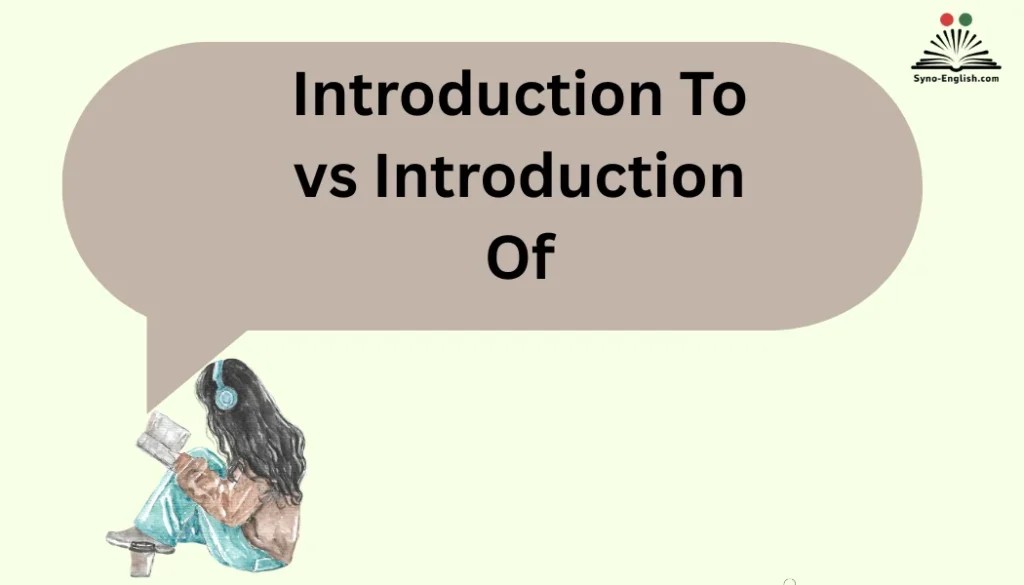Many English learners stumble when using prepositions, and Introduction To vs Introduction Of often causes deep confusion among even native speakers. The difference might appear small, yet it changes the meaning of a sentence entirely.
From my experience in teaching and writing, I’ve seen how easily words that seem interchangeable can lead to mistakes when not carefully understood.Using introduction to means guiding someone toward learning or exploring something new — such as an article serving as an introduction to grammar or a concept.
In contrast, introduction of suggests bringing something into existence, like the introduction of new rules or ideas. The nuances are subtle but essential, especially when forming a phrase that feels natural and correct in real-world applications.
Breaking Down the Core Difference
The quickest way to understand the difference is this:
- “Introduction to” means presenting someone or something to a person, audience, or subject. It suggests direction or exposure.
- “Introduction of” means presenting someone or something as the subject itself. It points to possession, presentation, or announcement.
Think of it this way:
“Introduction to” is about connection.
“Introduction of” is about announcement.
Analogy: Imagine walking into a party. If someone says, “Let me give you an introduction to Sarah,” they’re connecting you with Sarah. If they say, “Here’s the introduction of Sarah,” they’re formally announcing Sarah to the group.
Grammar and Contextual Usage
Prepositions shape meaning. With the word “introduction,” the choice of “to” or “of” dramatically shifts intent.
- To → expresses direction, purpose, or exposure.
- Example: An introduction to Shakespeare = exposure to Shakespeare’s work.
- Of → expresses possession, association, or formal announcement.
- Example: The introduction of a new policy = the act of bringing in the policy.
Key point: To moves you toward something. Of signals ownership or origin.
Historical and Linguistic Roots
The word “introduction” comes from the Latin introducere, meaning “to lead in.” In Middle English, it carried both senses of “bringing in” and “presenting to.” Over time, prepositions began refining these nuances.
- “Introduction to” became widely used in education and social contexts by the 18th century.
- “Introduction of” emerged strongly in formal, legal, and political writing during the same period.
Example from history:
- 1795: “An Introduction to the Study of Chemistry” (textbook title).
- 1801: “The introduction of new parliamentary reforms.”
The roots show us why both forms persist today: one reflects exposure, the other reflects formal presentation.
“Introduction To”: When and How to Use It
Use “introduction to” when you want to show exposure or guidance toward a person, subject, or activity.
Academic and Educational Contexts
- Introduction to Psychology (course title)
- An introduction to coding for beginners
This form is standard in academia because it signals “entry-level” or “beginner-friendly.”
Social Settings
- Let me give you an introduction to my cousin.
- That dinner was my introduction to authentic Thai food.
Here, “to” implies exposure or connection.
Professional and Training Contexts
- An introduction to company values
- Introduction to workplace safety training
Examples:
- Her first job was an introduction to the corporate world.
- This guide serves as an introduction to effective communication.
“Introduction Of”: When and How to Use It
Use “introduction of” when something is formally announced, presented, or implemented.
Formal Announcements
- The introduction of the keynote speaker by the host.
- The introduction of the president at the ceremony.
Laws, Policies, and Products
- The introduction of new tax reforms sparked debate.
- Apple announced the introduction of its latest iPhone.
Everyday Uses
- The introduction of stricter rules surprised the staff.
- The introduction of new flavors excited customers.
Examples:
- The introduction of hybrid cars changed the auto industry.
- The introduction of email revolutionized communication.
Side-by-Side Comparisons
Here’s a quick reference table that contrasts the two:
| Phrase | Meaning | Example Sentence |
| Introduction to | Exposure, direction, or connection | The workshop was my introduction to public speaking. |
| Introduction of | Formal presentation or announcement | The introduction of new software improved efficiency. |
Quick test: If you can replace “introduction” with “exposure” → use to. If you can replace it with “announcement” → use of.
Common Mistakes and How to Avoid Them
Even advanced learners mix these up. Here are pitfalls to watch out for:
- Saying “introduction of physics” instead of “introduction to physics.”
- Using “introduction to a new law” when it should be “introduction of a new law.”
Tips to Avoid Errors:
- If it’s about studying/learning → use to.
- If it’s about announcing/implementing → use of.
Mnemonic Device:
- T in to = Teaching/Training.
- O in of = Official/Origin.
Which Form is More Common?
Corpus studies show:
- “Introduction to” dominates in education, publishing, and general writing.
- “Introduction of” appears most in formal reports, government documents, and press releases.
Data Snapshot (Google Books Ngram, 1900–2019):
- Introduction to → much higher frequency overall.
- Introduction of → steady usage, but less common outside official contexts.
Conclusion: Use introduction to for most everyday contexts, but switch to introduction of for formal or policy-related writing.
Special Cases and Other Prepositions
Though to and of are the most common, other prepositions sometimes pair with “introduction.”
- Introduction by → The introduction by the author was brief.
- Introduction for → This booklet is an introduction for new employees.
- Introduction at → rare, but used in event contexts (his introduction at the awards).
Avoid incorrect forms like “introduction about” or “introduction into,” which are non-standard in most contexts.
Practical Applications: Writing & Speaking Better
Understanding the difference improves clarity in both writing and speech.
Real-Life Applications
- Academic Writing: Say “Introduction to Linguistics” instead of “Introduction of Linguistics.”
- Business Communication: Say “The introduction of new software” when launching a product.
- Social Speech: Say “I’ll give you an introduction to my friend” when making connections.
Quick Checklist Before Using “Introduction” Phrases
- Are you exposing or teaching? → to
- Are you announcing or implementing? → of
- Is it formal? → lean toward of
- Is it casual/educational? → lean toward to
Conclusion
Mastering the use of Introduction To vs Introduction Of may seem like a small detail, but it plays a big role in communicating ideas clearly and professionally. When you use introduction to, you are usually referring to the act of learning, exploring, or being guided toward a subject. On the other hand, introduction of means bringing something new into being, like introducing a law, idea, or product. These subtle nuances shape how a sentence is understood and can change the meaning entirely. Understanding them helps learners, writers, and even native speakers avoid confusion and improve their overall command of English.
Through my years of teaching and writing, I’ve learned that paying attention to these phrases builds confidence and fluency. Once you grasp the difference, you begin to use each naturally in your writing and speech. It’s a skill that transforms not just your grammar but your ability to express ideas with accuracy and style. By practicing with real-world examples, learners can avoid common mistakes and develop the clarity that makes their sentences powerful and precise.
FAQs
What does “introduction to” mean?
It means learning or being guided toward a new subject or idea, such as “an introduction to biology.”
What does “introduction of” mean?
It refers to bringing something new into existence, like “the introduction of new laws.”
Why is the difference important?
Because using the wrong one can completely change the meaning of your sentence.
Can both be used interchangeably?
No, they have distinct meanings and cannot replace each other.
Which one refers to teaching?
“Introduction to” is used when someone is learning or being introduced to a topic.
Which one introduces a concept or product?
“Introduction of” fits when something new is being launched or presented.
Why do English learners confuse them?
Because both phrases look similar and are used in related contexts.
How can I remember the difference easily?
Think of “to” as direction (learning) and “of” as creation (bringing into being).
Are these common mistakes among native speakers?
Yes, even native speakers sometimes mix them due to habit or lack of attention.
How can I practice using them correctly?
Read examples, write sentences, and focus on the purpose — learning uses “to,” creation uses “of.”

Emma Brooke is a passionate English educator, writer, and language enthusiast with over a decade of experience helping learners master the nuances of the English language. At SynoEnglish, she blends practical grammar advice with real-world communication tips to make English easier, clearer, and more enjoyable for readers of all levels.



